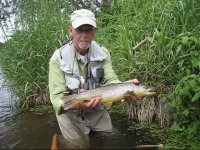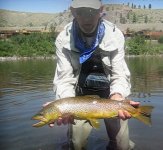IMO you question is watershed specific and species specific. I've caught big trout all over the state, including streams less than 5 foot wide.
1) Fish streams that are known to have large trout.
2) streams like the letort, while you can catch a big fish on top, you are better served fishing sub surface.
3) streams like the Lackawanna,penns, etc..., while you can catch a big fish subsurface, you are better served fishing dries during a hatch.
Big river trout will rise during a hatch.
4) fish marginal,in transitional areas, with big stuff during mild season changes ie (winter into spring summer into fall). Big fish migrate around in these waters but be prepared for days with no trout too.
5) study the area very hard. Learn your watershed. It pays big dividends.
6) fish for large browns at night.
All that said I prefer large, articulated streamers for big trout. Unless I see them rise







